Wildflowers, Grasses and Other Nonwoody Plants
Media
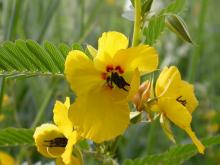
Species Types
Scientific Name
Chamaecrista fasciculata (formerly Cassia fasciculata)
Description
The interesting, bright yellow flowers of showy partridge pea are immediately recognizable. At night, the leaflets close and pull upward into a sleeping position.
Media

Species Types
Scientific Name
Viola pubescens (formerly V. pensylvanica)
Description
The yellow violet is Missouri's only all-yellow violet. This native wildflower is less common than violet violets. Look for it in low woods, rich slopes, and wooded floodplains.
Media
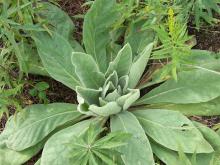
Species Types
Scientific Name
Verbascum thapsus
Description
Mullein immigrated to America along with Europeans, and with them it has spread across the continent. Its fuzzy, green-gray rosettes of leaves and tall spikes of yellow flowers make it easy to identify.
Media
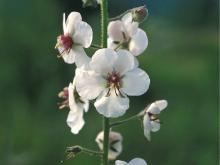
Species Types
Scientific Name
Verbascum blattaria
Description
Moth mullein is a native of Eurasia introduced to our continent in the early 1800s. Since then, it has spread across North America. It’s named because the fuzzy flower, with 2 antennalike stamens, looks something like a moth.
Media
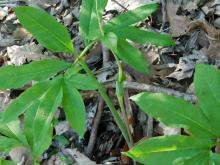
Species Types
Scientific Name
Arisaema dracontium
Description
What could be cooler than finding a green dragon? This leafy green plant with a long, noodly spadix is closely related to Jack-in-the-pulpit. It occurs in the same habitats but is less common and easily overlooked.
Media

Species Types
Scientific Name
Uvularia grandiflora
Description
A common spring wildflower found in forests nearly statewide, large bellwort has bell-shaped flowers that droop downward. The yellow petals sometimes look twisted, almost wilted.
Media

Species Types
Scientific Name
Aureolaria pectinata (formerly Gerardia pedicularia)
Description
There are 3 species of Aureolaria in Missouri. Only combleaf yellow false foxglove is annual, has fernlike, delicately dissected leaves, and glandular hairs. It occurs in the Ozarks.
Media

Species Types
Scientific Name
Ludwigia peploides
Description
Water primrose is a common shoreline plant with bright yellow flowers and long, trailing stems. It grows in dense mats in the shallow areas of ponds, lakes, and streams.
Media
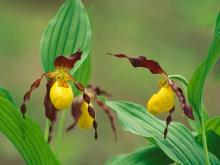
Species Types
Scientific Name
Cypripedium calceolus
Description
Yellow lady’s slipper is found statewide. It is among our showiest native orchids, and suffers from its popularity. Although orchids rarely survive transplanting, people try digging them up anyway.
Media
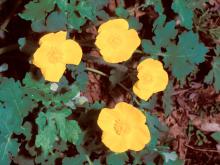
Species Types
Scientific Name
Stylophorum diphyllum
Description
The showy, bright yellow flowers of celandine poppy really stand out in the shady woods and valleys where this plant grows. You should consider this species when you are planting a shade garden!
See Also
About Wildflowers, Grasses and Other Nonwoody Plants in Missouri
A very simple way of thinking about the green world is to divide the vascular plants into two groups: woody and nonwoody (or herbaceous). But this is an artificial division; many plant families include some species that are woody and some that are not. The diversity of nonwoody vascular plants is staggering! Think of all the ferns, grasses, sedges, lilies, peas, sunflowers, nightshades, milkweeds, mustards, mints, and mallows — weeds and wildflowers — and many more!





















